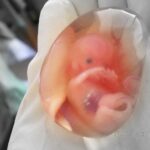Culture, International Politics
Scotland’s birth rate at its lowest since 1855, the year it started keeping records
In a grim essay last December in First Things, British writer Louise Perry detailed a laundry list of crises in the United Kingdom and across the Western world, and then bluntly laid out the primary source of these problems.
“The people on whom modernity depends are failing to reproduce themselves, which means that modernity itself is failing to reproduce itself,” she wrote. “Most voters have no idea that this is happening. Nor do most politicians. But it is happening nonetheless, and we are experiencing its early stages in the form of diverse political crises across the modern world.”
If the utter collapse of birth rates is any indication, the West is shriveling and dying. Populist politicians can say whatever they like about curtailing mass migration and canceling cancel culture and embracing our heritage. But none of it will matter if nobody has babies. Without babies, there is no future. That should go without saying. But the fact is that few are saying it, and it is happening. Almost every week brings a new grim headline about our population freefall.
According to new data from the National Records of Scotland, for example, a mere 45,763 live births were registered in 2024, 172 fewer than in 2023. This is the lowest birth rate since 1855, marking yet another decrease in the country’s fertility rate from 1.27 to 1.25. 1855, by the way, is when records first began to be kept.
As the BBC put it: “The NRS said that for a population to replace itself, if there is no migration, the total fertility rate needed to be around 2.1. It said the overall numbers reflected ‘long-term changes in our population.’” But there seems to be little interest in discussing what those “long-term changes” mean if these trends continue, as it seems likely that they will. Keep in mind that these changes are happening even as the stillbirth rate is also the lowest recorded, and the infant death rate fell to 3.5 per thousand live births.
The report included a few other grim statistics, as well. In 2024, there were 16,528 more deaths in Scotland than births. Scotland has now had more deaths than births each year for a decade. Fifty years ago, most women had babies in their 20s. Now, for the past 15 years, most babies are born to mothers over thirty. Over half of babies – 51.7 percent – were born out of wedlock. Meanwhile, 18,710 babies were aborted in Scotland last year, the highest on record according to Public Health Scotland. The abortion rate per 1,000 women aged 15 to 44 rose to 17.9.
Meanwhile, Scotland – like the rest of the United Kingdom – actually funds, with taxpayer dollars, both abortion and birth control. It is difficult to conceive of a more suicidal social policy than paying for the elimination and prevention of the next generation, but it is unquestioned and unquestionable political orthodoxy that to do so is a necessity. Why? Because in practice, fewer children appears to have been the de facto goal of successive governments for a very long time, despite all their garbled noises to the contrary.
The collapse in birth rates, Louise Perry writes, seems to be modernity’s “self-destruct button,” which we have tripped. “The nature of geometric progressions means that a population drop can be very sudden if the fertility rate does not recover to replacement level. When fewer children are born, fewer future parents are available to raise the next generation, and so on,” she observed. “In South Korea – the country with the world’s lowest TFR, at 0.7 – the number of babies born in 2100 is on track to be 93 to 98 percent lower than the number of babies born this year.”
Indeed. These words have stuck with me since I read them: “No disease or invading army has ever managed to destroy a country so thoroughly, and the word that springs to my mind, when contemplating such an event, is ‘biblical.’”








